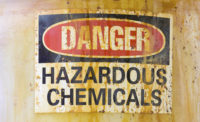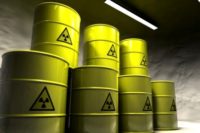Hazardous waste containment and the role of right containers

The United States produces around 265 million metric tons of hazardous waste every year. With ongoing incidents, hazardous waste containment and disposal have become an increasing concern in recent times. In July 2020, a Boise-based agribusiness giant, J. R. Simplot company had to pay a whopping fine worth $775,000 for illegally placing hazardous material in a waste pile of calcium sulfate by-products. The right type of containers facilitates efficient hazardous waste management, thereby helping businesses avoid such costs.
Hazardous waste characteristics that call for cautious storage
Inherent characteristics of hazardous waste demand stringent storage requirements. According to the EPA, hazardous wastes are classified into four categories based on their properties.
- Ignitability: This category includes inflammable substances such as solids that can catch fire spontaneously, liquids with low flash points (gasoline, acetones, alcohols, etc.), compressed gases, and oxidizers. Such waste materials require special handling due to their temperature sensitivity.
- Corrosivity: It consists of liquids with pH lower than or equal to 2 and higher than or equal to 12.5. Such materials need containers with compatible material as they can eat through certain container-materials resulting in leakage of harmful substances. Materials like sulfuric acid, nitric acid, and hydrochloric acid come under this classification.
- Reactivity: Reactive materials are volatile and need the utmost care while handling. They can undergo violent changes without detonating, release toxic gases when mixed with water, and cause violent reactions or form potentially explosive mixtures.
- Toxicity: Such materials pose a threat to groundwater and have a long-lasting impact on the environment and human health. According to the EPA, these types of materials need immediate containment.
Hazardous waste containers: what you need to know about selecting them
Due to the specific characteristics of hazardous wastes, you need to be extremely cautious while storing them. Here are a few aspects you should think of while selecting the containers for your hazardous waste.
Container Types and Sizes: As a hazardous waste generator, you must ensure that your waste containers comply with the most current regulations and codes. The EPA suggests the following types of hazardous waste storage containers.
- Drums: They are available in various sizes, including 5, 10, 20, 30, and 55 gallons. The 55-gallon drums are most commonly used.
- Containers: Portable devices such as roll-off containers to manage, store, and transport hazardous waste.
- Tanks: Open or closed stationary devices such as closed-top frac tanks, vacuum container tanks, and boxes.
- Containment Buildings: Self-supporting, entirely enclosed structures for treatment and storage of non-containerized hazardous waste.
- Totes with Exterior Metal Cages and Inner Linings: Primarily used for liquid waste. The metal cage prevents the totes from puncturing.
- Drop Pads: Wood drying structure for collecting excess wood preservatives and drippings.
- Surface Impoundments: Man-made diked area or excavation such as settling lagoon, storage pit, or holding pond, a natural topographical depression.
- Waste Piles: Uncovered, open piles for storage, and treatment of hazardous waste.
Out of the above, the smaller containers are made of plastic. Tanks and containers are ideal for those waste generators who fill up drums too quickly. You can select your container based on the size and type of hazardous waste.
The material of the container: Properties of the hazardous waste need specific container materials to contain them safely and effectively. For example, corrosive waste should transport in polyethylene storage as it can corrode metal containers, resulting in hazardous leaks. On the other hand, steel containers are the best to contain flammable waste. Biohazard waste needs a different set of preparation altogether, including freezable bio-bottles and biohazard pouches.
Best management practices for hazardous waste containers
Besides selecting the right container, here are some of the best management practices to ensure the safe and effective management of hazardous waste containers.
- Container maintenance: Containers’ condition is as critical as the type of hazardous waste they contain. Check containers periodically for any adverse development such as leaks, rusting, or cracks. Ensure that all lids are attached and sealed correctly. Based on the type of waste, ensure that your containers are complying with air emission standards. Regularly check for dents, dings, or anything unusual. In case of any doubt, it’s always safe to repackage the waste.
- Label hazardous waste properly: Hazardous waste generators must follow RCRA regulations to label, mark, and placard the waste appropriately. It includes the composition and physical state of the waste, the name and address of the generator, the statement mentioning the hazardous waste properties, and the accumulation start date of the waste, among other information.
- Ensure that you know everything in the hazardous waste container: The situation becomes tricky if your container consists of multiple hazardous waste types. They can interact adversely even when present in a residual proportion, such as a reused container. It can lead to toxic fumes, fires, explosions, or even complete container failure. Therefore, it’s critical for you to meticulously segregate and store each type of hazardous waste in the appropriate types of containers.
- Be prepared for potential spill containment: It’s vital to have the necessary tools to contain and clean any potential spills or leaks quickly and correctly. It will minimize any potential adverse impacts on the environment and people.
Conclusion
Hazardous waste containment is critical for saving excessive fines and the safety of the environment and human health. Selecting an appropriate container based on the type and amount of waste and maintaining best practices such as regular inspection, proper labeling, and containment-readiness go a long way to contain hazardous waste efficiently.
Looking for a reprint of this article?
From high-res PDFs to custom plaques, order your copy today!








